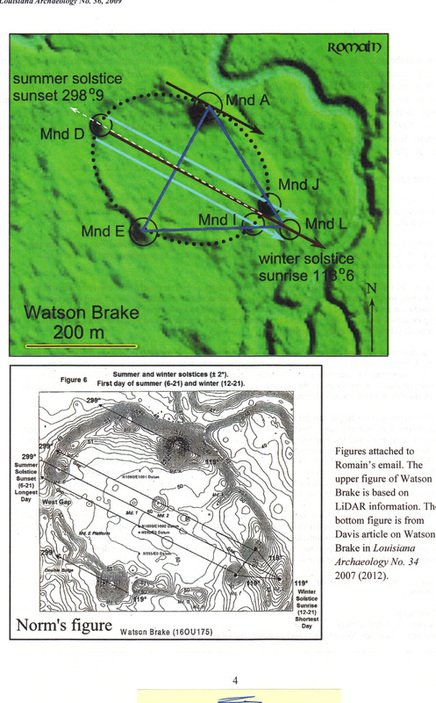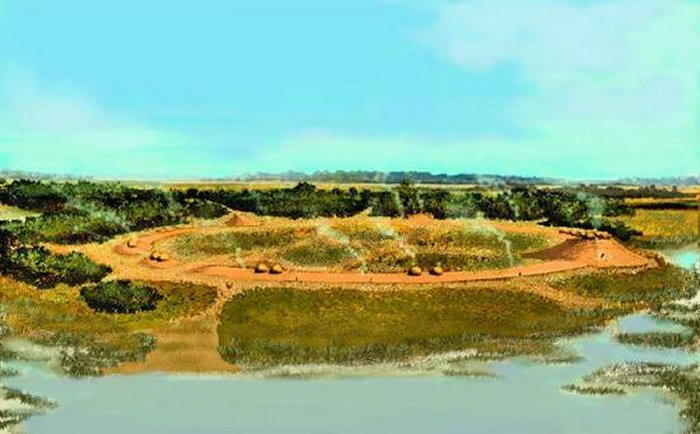Mysterious Watson Brake: Oldest Mound Complex In North America With Earthworks Raised For Unknown Purpose
MessageToEagle.com – In northern Louisiana, North America there is a very interesting and mysterious ancient site known as Watson Brake. This ancient site challenges our knowledge about North American history as the mounds have been found to be the earliest known remnants of human construction in the New World.
Mounds At Watson Brake Were Raised By Complex Ancient Society
Located in the floodplain of the Ouachita River near Monroe, Watson Brake consists of 11 ancient mounds that measure from three to 25 feet in height.

The construction of the mounds started about 5,400 years ago, predate other similar public architecture at Indian sites by nearly 2,000 years. This suggests the region was inhabited by a pre-agriculture, pre-ceramic hunting society that was much more socially complex than previously thought.
What we understand about the Mound Builders is changing as a result of research in the last decade.
What Was the Purpose Of The Mounds?
According to many archaeologists the purpose of the mounds is unknown. Since no human remains or ceremonial objects have been found, so perhaps the mounds were not used for burial or religious purposes.
On the other hand, the area enclosed by the mounds was kept clean of debris, suggesting its use as ritual space. The reasons why such elaborate activities first occurred here remain elusive. Another possibility is that the mounds were originally built to protect Native Americans from floods.
Yet, it seems logical to assume our ancestors must have had a reason for building these mounds. The surfaces of the ridges and mounds show little evidence of occupation, leading archaeologists to believe that Watson Brake was occupied primarily before and during the building of the mounds.
William F. Romain, Ph.D who runs the Ancient Earthworks Project believes Watson Brake is the oldest solstice-aligned earthwork complex in the Americas.
The ancient mounds are very difficult to access because half of the site is on private property, making it very restricted. The Archaeological Conservancy purchased the other half of the site in 1996.

In 2014, William F. Romain was finally given permission to visit the site and he invited Dick Shiels, Director of the Newark Earthworks Center, and Bill Monaghan, Associate Director of the Glenn Black Laboratory to accompany him. Using LIDAR technology, William F. Romain discovered Watson Brake was indeed an important archaeoastronomical site that our ancestors used for sky watching.
See also:
Enigma Of The Ancient Berkeley Mystery Walls – The “Great Wall Of California”
Emerald Mound In The Ancient City Of Natchez: Second Largest Temple Mound In North America
Wupatki Ruins And Sacred Sunset Crater Of Ancestral Puebloans In Arizona
More Fascinating Ancient Civilizations And Places
The theory that Watson Brake was an ancient astronomical site is not far-fetched. Watson Brake is just like Poverty Point located in Louisiana.

Poverty Point, is still a place that remains a prehistoric mystery. It has been suggested that the Poverty Point octagon was the world’s largest ancient solstice marker. The massive earthworks at Poverty Point near Epps were long considered the beginning of extensive mound construction.
Based on numerous discoveries, researchers now have reason to believe that mound construction was widespread by 3000 BC in northern and southern Louisiana as well as Mississippi and Florida.

Were the Watson Brake mounds and huge earthworks at Poverty Point built by the same culture?
There are also scientists who think the ancient mounds at Watson brake might have been raised without a purpose.
”I know it sounds awfully Zen-like, but maybe the answer is that building them was the purpose, ‘Dr. Bruce D. Smith, an archeologist and specialist in early American agriculture at the Smithsonian Institution in Washington said.
Tristam Kidder, associate professor of anthropology at Tulane University, said the archaeological sites found along the Ouachita River are both typical of those found elsewhere in the southeastern United States and also unique. They are unique in that they are older, but the earlier sites are more or less similar to the rest of the southeast in general characteristics, Kidder said.
It is very difficult say anything with certainty about Watson Brake. Few archaeological excavations have been conducted at the site and the full extent of the first earthworks is not yet known.
Watson Brake earthworks are a testimony to the complexity of an ancient culture that still remains largely a mystery.
Copyright © MessageToEagle.com All rights reserved. This material may not be published, broadcast, rewritten or redistributed in whole or part without the express written permission of MessageToEagle.com
Expand for references









